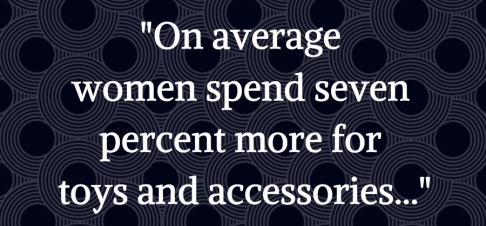Women have been discriminated against for centuries. They are often seen as the weaker sex because they are more compassionate and emotionally driven.
Financial discrimination is a big factor in the oppression of women. Females make 79 cents for every dollar a man makes. On top of that, females have to deal with a gender tax or “pink tax.” This tax is seen when comparing items made for females and the same items made for males.
Products such as razors, deodorant, hair care products and even clothing reveal that women are paying more money just because they are women. Children’s toys have also seen pricing differences between ones advertised to boys and the ones advertised to girls.
“When stores separate their products into men’s and women’s sections it is hard for the consumer to pick up on the fact that there is price variances on basically the same products,” business administration professor Vonya Womack said. “Manufactures and marketers know that marketing higher priced items to women will entail some women to not know the men’s products in the same categories are cheaper and plus women will pay a premium for items that they consider to be worth spending more money on.”

Products are priced based on the decision of management and the company. Marketers consider factors such as the cost of making the product, what the market is like at the time, competition and the brand.
“Nike for example is able to price their items higher because their brand is associated with consumers minds that they are getting a better product when that same product could be sold with a different branding and it would not be considered to be worth paying a higher price for,” Womack said. “Even if both items were manufactured in the same place.”
“As a female, I have done my fair share of shopping in my lifetime and I have actually come to notice that women’s clothes are more expensive than men’s clothes,” Betsy Comas, freshman biology major, said. “I personally believe that it is unfair for women to have to pay more money than men for a similar product. In my opinion this is sexist.”
The New York City Department of Consumer Affairs (DCA) conducted a study on how much more money women will spend in their lifetime compared to their male counterparts. On average women spend seven percent more for toys and accessories, four percent more for children’s clothing, eight percent more for adult clothing, 13 percent more for personal care products and eight percent more for senior/home health care products.
Only five products out of the 35 tested had the female version priced higher. At the end of the study, the DCA concluded that female products were priced more than male products 42 percent of the time and products for males being priced higher 18 percent of the time. This is considered a form of gender discrimination.
“There are multiple pricing strategies in marketing and business, but when it comes down to it there is really no specific strategy that will work for every kind of product or market,” Womack said. “Usually marketers look at who the target customer is, they do market research to find out what their competitors are pricing and marketers have to have a good idea about quality of the product and the price it should be set at to gain the most market share and at the same time make a profit.”
It was also reported that in 1994, California looked at the issue of gender-based pricing of services and estimated that women paid an annual gender tax of about $1,351 for the same services as men.
“The fact that women have to pay more money than men for clothing, is a discrimination based on gender,” Comas said. “Women often face discrimination at work and within society.”
Since women are consumers, they do not have control over why their prices are higher than men’s. Items marketed to females on average cost seven percent more than those marketed to males based on quality.
“Some marketers will say it is more about what the customers know about the products and less about the specific price, meaning women are considered and expected to know more about products in certain categories like cosmetics,” Womack said. “By pricing products higher for women, marketers are more likely to get women to move on the pricing scale and spend more on a product category just based on their knowledge of understanding the differences in the products.”

The DCA also reported that women spend an average of 25 percent more on haircuts than men that require the same amount of labor. They also spend more money on having a white cotton shirt dry cleaned.
In 1998, New York City banned gender discriminatory prices for services. Businesses must offer gender neutral prices for the same amount of labor intensity. DCA inspectors found 129 violations for gender pricing of services in 2015 compared to 118 in 2014.
“In my opinion, this does make a positive change because it somewhat decreases the discrimination that exists towards women, giving women the opportunity to feel equal and somewhat accepted in this sexist society that we live in,” Comas said.
In 1991, a professor at Yale sent women and men to car dealerships in the Chicago area. He found that women were asked to pay a 40 percent higher markup than the men. This supports the stereotype that women know less about cars than men. When race was factored in an African American woman was asked to pay three times more.
The issue of a gender tax does not just exist in the United States. Stores in France have also been accused of this. Pink is considered a “luxury” color.
Pascale Boistard, the secretary for women’s rights, tweeted, “is pink is a luxury colour?” to show her support for the feminist campaign. The word “luxury” should not be used to describe products used to maintain the how women are supposed to be groomed. Luxury describes items that allow indulgence. The campaign brings light to the issue that women are constantly being told they are not good enough and must continue to conform to societal standards of how they should look.
“Society praised these unrealistic ideals of body image for women, which is probably why women have to pay more for clothing,” Comas said. “The price increase is society’s way of telling women that if they want to be ‘socially accepted’ and be considered a woman, they need to pay more for their attire.”


